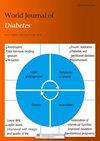Comparative study of type 2 diabetes mellitus-associated gut microbiota between the Dai and Han populations
IF 4.2
3区 医学
Q1 ENDOCRINOLOGY & METABOLISM
引用次数: 0
Abstract
BACKGROUND The global prevalence of type 2 diabetes mellitus (T2DM) is increasing. T2DM is associated with alterations of the gut microbiota, which can be affected by age, illness, and genetics. Previous studies revealed that there are discriminating microbiota compositions between the Dai and the Han populations. However, the specific gut microbiota differences between the two populations have not been elucidated. AIM To compare the gut microbiota differences in subjects with and without T2DM in the Dai and Han populations. METHODS A total of 35 subjects of the Han population (including 15 healthy children, 8 adult healthy controls, and 12 adult T2DM patients) and 32 subjects of the Dai population (including 10 healthy children, 10 adult healthy controls, and 12 adult T2DM patients) were enrolled in this study. Fasting venous blood samples were collected from all the subjects for biochemical analysis. Fecal samples were collected from all the subjects for DNA extraction and 16S rRNA sequencing, which was followed by analyses of the gut microbiota composition. RESULTS No significant difference in alpha diversity was observed between healthy children and adults. The diversity of gut microbiota was decreased in T2DM patients compared to the healthy adults in both the Dai and Han populations. There was a significant difference in gut microbiota between healthy children and healthy adults in the Han population with an increased abundance of Bacteroidetes and decreased Firmicutes in children. However, this difference was less in the Dai population. Significant increases in Bacteroidetes in the Han population and Proteobacteria in the Dai population and decreases in Firmicutes in both the Han and Dai population were observed in T2DM patients compared to healthy adults. Linear discriminant analysis Effect Size analysis also showed that the gut microbiota was different between the Han and Dai populations in heathy children, adults, and T2DM patients. Four bacteria were consistently increased and two consistently decreased in the Han population compared to the Dai population. CONCLUSION Differences in gut microbiota were found between the Han and Dai populations. A significant increase in Bacteroidetes was related to the occurrence of T2DM in the Han population, while a significant increase in Proteobacteria was related to the occurrence of T2DM in the Dai population.傣族与汉族 2 型糖尿病相关肠道微生物群比较研究
背景 2 型糖尿病(T2DM)的全球发病率正在上升。T2DM 与肠道微生物群的改变有关,而肠道微生物群的改变可能受到年龄、疾病和遗传的影响。以往的研究表明,傣族和汉族人群的微生物群组成存在差异。然而,这两个人群之间具体的肠道微生物群差异尚未得到阐明。目的 比较傣族和汉族人群中患有和未患有 T2DM 的受试者的肠道微生物群差异。方法 本研究共纳入 35 名汉族受试者(包括 15 名健康儿童、8 名成年健康对照者和 12 名成年 T2DM 患者)和 32 名傣族受试者(包括 10 名健康儿童、10 名成年健康对照者和 12 名成年 T2DM 患者)。研究人员采集了所有受试者的空腹静脉血样本进行生化分析。收集所有受试者的粪便样本进行 DNA 提取和 16S rRNA 测序,然后分析肠道微生物群的组成。结果 健康儿童和成人的α多样性无明显差异。与健康成人相比,傣族和汉族人群中 T2DM 患者的肠道微生物群多样性均有所下降。在汉族人群中,健康儿童和健康成人的肠道微生物群存在明显差异,儿童中的类杆菌增多,而真菌减少。然而,这种差异在傣族人群中较小。与健康成人相比,在 T2DM 患者中观察到汉族人群中的类杆菌属和傣族人群中的变形菌显著增加,而汉族和傣族人群中的固缩菌显著减少。线性判别分析效应大小分析也显示,在健康儿童、成人和 T2DM 患者中,汉族和傣族人群的肠道微生物群有所不同。与傣族人群相比,汉族人群中有四种细菌持续增加,两种细菌持续减少。结论 发现汉族和傣族人群的肠道微生物群存在差异。在汉族人群中,类杆菌的显著增加与 T2DM 的发生有关,而在傣族人群中,变形菌的显著增加与 T2DM 的发生有关。
本文章由计算机程序翻译,如有差异,请以英文原文为准。
求助全文
约1分钟内获得全文
求助全文
来源期刊

World Journal of Diabetes
ENDOCRINOLOGY & METABOLISM-
自引率
2.40%
发文量
909
期刊介绍:
The WJD is a high-quality, peer reviewed, open-access journal. The primary task of WJD is to rapidly publish high-quality original articles, reviews, editorials, and case reports in the field of diabetes. In order to promote productive academic communication, the peer review process for the WJD is transparent; to this end, all published manuscripts are accompanied by the anonymized reviewers’ comments as well as the authors’ responses. The primary aims of the WJD are to improve diagnostic, therapeutic and preventive modalities and the skills of clinicians and to guide clinical practice in diabetes. Scope: Diabetes Complications, Experimental Diabetes Mellitus, Type 1 Diabetes Mellitus, Type 2 Diabetes Mellitus, Diabetes, Gestational, Diabetic Angiopathies, Diabetic Cardiomyopathies, Diabetic Coma, Diabetic Ketoacidosis, Diabetic Nephropathies, Diabetic Neuropathies, Donohue Syndrome, Fetal Macrosomia, and Prediabetic State.
 求助内容:
求助内容: 应助结果提醒方式:
应助结果提醒方式:


